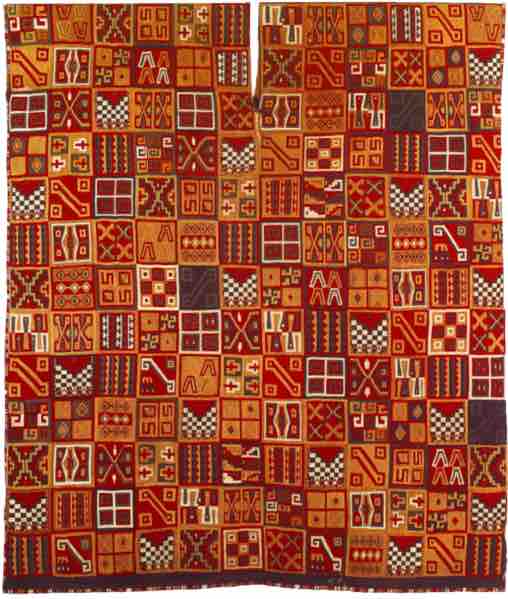Background: Chimú Textiles
The Incas were highly regarded for their textiles, influenced by the artistic works of the pre-Inca Chimú culture. The Chimú, who arose about 900 CE, were conquered in a campaign led by the Inca ruler Tupac Inca Yupanqui around 1470 AD.
The Chimú embellished their fabrics with brocades, embroidery, fabric doubles, and painted fabrics. Textiles were sometimes adorned with feathers, gold, or silver plates. Colored dyes were created from plants containing tannin, mole, or walnut; these dyes also came from animals like the cochineal and minerals like clay, ferruginosa, and mordant aluminum. Garments were made of the wool of four animals: the guanaco, llama, alpaca, and vicuña. The people also used varieties of cotton that grew naturally in seven different colors. Clothing consisted of the Chimú loincloth, sleeveless shirts, small ponchos, and tunics.
Textiles in the Inca Empire
Textiles were widely prized within the Inca empire—in part because they were somewhat easily transported—and were widely manufactured for tax collection and trade purposes. Cloth and textiles were divided among the classes in the Inca empire. Awaska was used for common clothing and traditional household use and was usually made from llama wool. Qunpi, a finer cloth, was divided into two classes: it would either be made of alpaca wool and collected as tribute for use by royalty, or it would be woven from vicuña wool and used for royal and religious purposes. The finest textiles were reserved for the rulers as markers of their status. For example, Inca officials wore stylized tunics decorated with certain motifs, and soldiers of the Inca army had specific uniforms.

Tupa Inca tunic from around 1550
An example of Inca textiles. Inca officials wore stylized tunics decorated with certain motifs, while soldiers of the Inca army had specific uniforms.
The Weaving Tradition
The weaving tradition was very important to Incas in the creation of beautiful and elaborate woven headdresses. Royalty was clearly distinguished through decorative dress. Inca emperors, for example, wore woven hats trimmed with gold and wool tassels or topped with plumes or showy feathers. Incas also created elaborate feather decorations for men, such as headbands made into crowns of feathers, collars, and chest coverings. Wealthy Inca men wore large gold and silver pendants hung on their chests, disks attached to their hair and shoes, and bands around their arms and wrists. Inca women adorned themselves with a metal fastening for their cloak called a tupu, and the head of their tupu was decorated with paint or silver, gold, or copper bells.